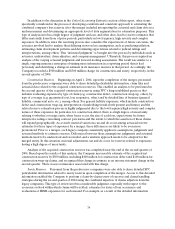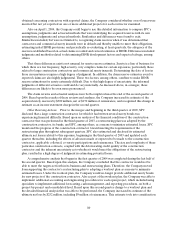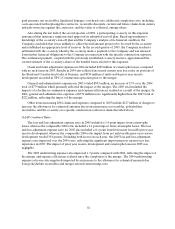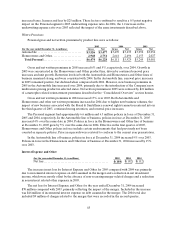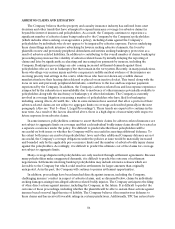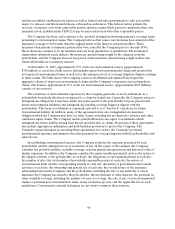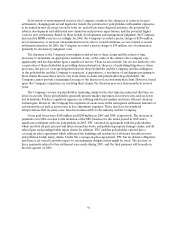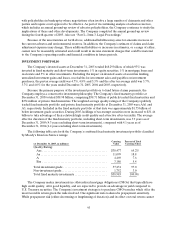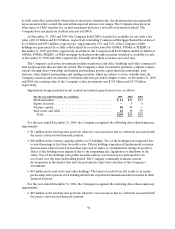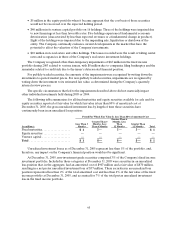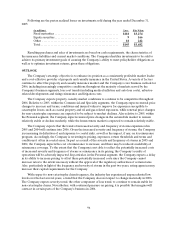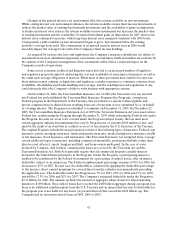Travelers 2005 Annual Report Download - page 99
Download and view the complete annual report
Please find page 99 of the 2005 Travelers annual report below. You can navigate through the pages in the report by either clicking on the pages listed below, or by using the keyword search tool below to find specific information within the annual report.87
settlement agreements, which have been approved by the court in connection with the proceedings
initiated by TPC in the Johns Manville bankruptcy court. If the rulings of the bankruptcy court are
affirmed through the appellate process, then TPC will have resolved substantially all of the direct action
pending claims against it. (Also, see “Part I—Item 3, Legal Proceedings”).
Because each policyholder presents different liability and coverage issues, the Company generally
reviews the exposure presented by each policyholder on a policyholder-by-policyholder basis. In the course
of this review, the Company considers, among other factors: available insurance coverage, including the
role of any umbrella or excess insurance the Company has issued to the policyholder; limits and
deductibles; an analysis of each policyholder’s potential liability; the jurisdictions involved; past and
anticipated future claim activity and loss development on pending claims; past settlement values of similar
claims; allocated claim adjustment expense; potential role of other insurance; the role, if any, of non-
asbestos claims or potential non-asbestos claims in any resolution process; and applicable coverage
defenses or determinations, if any, including the determination as towhether ornot an asbestos claim is a
products/completed operation claim subject to an aggregate limit and the available coverage, if any, for
that claim. When an estimate of the gross ultimate exposure for indemnity and related claim adjustment
expense is determined for a policyholder, the Company calculates, by each policy year, a ceded reinsurance
projection based on any applicable facultative and treaty reinsurance, past ceded experience and
reinsurance collections. Conventional actuarial methods are not utilized to establish asbestos reserves. The
Company’s evaluations have not resulted in any data from which a meaningful average asbestos defense or
indemnity payment may be determined.
The Company also compares its historical gross and net loss and expense paid experience, year-by-
year, to assess any emerging trends, fluctuations, or characteristics suggested by the aggregate paid activity.
Net asbestos losses and expenses paid in 2005 were $399 million, compared with $301 million in2004. This
increase was primarily driven by inclusion of the SPC business for the full year in 2005 and substantial
reinsurance recoveries in the third quarter of 2004. Approximately 42% in 2005 and 22% in 2004 of total
net paid losses relate to policyholders with whom the Company previously entered into settlement
agreements limiting the Company’s liability. The lower percentage experienced in 2004 reflected
substantial reinsurance billings during the year. In2005, gross payments associated with policyholders with
settlement agreements totaled $203 million, compared with $199 million in 2004.
At December 31, 2005, net asbestos reserves totaled $4.36 billion, compared with $3.93 billion at
December 31, 2004. The Company’s annual ground-up review of asbestos exposures resulted in a reserve
increase of $830 million in2005. In2004, the Company increased asbestos reserves by $922 million
following the same ground-up review process. Those reviews included an analysis of exposures and
payment patterns by policyholder category, as well as recent settlements, policyholder bankruptcies,
judicial rulings and legislative actions. The asbestos charge in 2005 resulted, in part, from higher than
expected defense costs due to increased trial activity for seriously impaired plaintiffs and prolonged
litigation before cases are settled or dismissed. The 2005 charge also considered the January 2006 court
decision voiding, on procedural grounds, the previously rendered favorable arbitration decision in the
ongoing ACandS litigation. The asbestos charge recorded in 2004 primarily resulted from an increase in
litigation costs and activity surrounding peripheral defendants.




